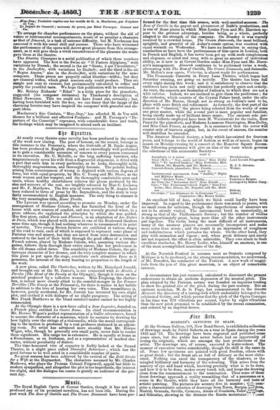lin iris.
ROBERTS'S SKETCHES IN SPAIN,
At the German Gallery, 168, New Bond Street, is exhibited a collection. of drawings made by David Roberts on a tour in Spain during the years 1832 and '33. The drawings have been engraved and published some years since, but the public has never before had an opportunity of seeing the originals, which are amongst the beat productions of the artist. The drawings are, of course, executed in water-colour. The manner of execution varies considerably, though the skill is the same in all. Some few specimens are painted with great freedom, others with as great finish; but the freest are as full of delicacy as the most elabo- rated. Nothing can excel the transparency of the shadows, or the mingled brilliancy and harmony of the colouring. This arises from the mastery of eye and hand which, knowing precisely what is to be done, and how it is to be done, makes every touch tell, and keeps the drawing clean from the commencement to the termination. Thus some of these freest drawings approach a reality resembling that of a panorama or a scene in the theatre, while they have all the harmony and taste of artistic painting. The pictures are seventy-five in number ; com- prise a characteristic selection of drawings from Xeres, Burgos. parNove, Madrid, Granada, Seville, Carmona, Alcala el Guadaira, Toler! icone,;itga,
and Gibraltar, showing in the distance the Ronda mountains ,,oast
of Barbary, and Ceuta, with that river-like strait which we have to keep free from closing. The pleasure afforded by these vivid pictures of Spain is greatly in- creased by careful descriptions of each picture, with-very spirited and genial remarks in illustration of the subjects. We are the more inclined to notice this catalogue, because it stands in marked contrast with those other collections that we have visited this winter, where the meagrest descriptions of the several pictures are catalogued in an order wholly different from that of the pictures on the walls ; so that as you pass round the room, every reference to learn the subject of the picture becomes an affair of painful and hindering research. We guess at the motive which causes this slovenly style of catalogue ; but we are convinced that no con- venience or saving to the exhibitor can compensate for the disgust it occasions to the public. The catalogue of Roberts's collection is a good modeL We have here all the picturesque variety for which Spain is noted,- the stupendous Alhambra Palace, vast and beautiful, the great modern palace at Madrid, the bull-ring, the cathedral, the ruined old monastery at Burgos, the Mosque of Cordova, and even remains of Rome ; Chris- tianity, Ancient Mythology, and Islam are all mingled in relics whose power and beauty mock the present state of the country. It is difficult to particularize in a collection by one painter, where each picture might in itself call for detailed analysis and criticism. Amongst the most striking are the interiors of the great cathedrals in which, with very simple handling, an effect of colour, space, grace, and grandeur, is produced that might rebuke many elaborate pictures on vast canvas. The introduction of the Roman remains is very happy, affording as it does so complete a contrast with the beautiful Moorish architecture,- the Roman rising rounded and firm from a solid basis, the Moorish, graceful, curved, and poised upon slender supports which still convey an idea of strength from their fitness and balance. Amongst the most striking pictures is the cathedral of Seville and its great towers with the sun rising behind it: a golden light has burst upon the routed night, the clouds look as though they were ruffled and cast back by the force of
i
the rays which the sun shook forth, while the town below is bathed in a semi-transparent, grey half-shadow. The effect of burst, the trans- parency, the glorious splendour and sober harmony is most eloquent.



























 Previous page
Previous page